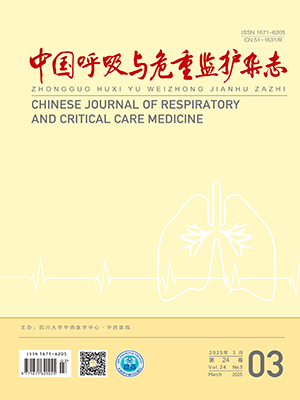Objective To evaluate the impacts of pulmonary rehabilitation at different levels of exercise intensity on health status of patients with moderate to severe COPD. Methods Thirty-two COPD patients treated with pulmonary rehabilitation by ergometry exercise were randomly assigned to exercise intensity level either by anaerobic threshold (AT group; n=15) or by maximum tolerate [high intensity group(HI group); n=17]. Nine COPD patients without exercise training served as control. Bicycle exercise training was conducted in two separate days each week for 12 weeks. Spirometry,cardiopulmonary exercise testing,the St George’s Respiratory Questionnaire (SGRQ) were accessed before and after the rehabilitation program. Results Exercise intensity (%Wmax) was significantly higher in HI group than AT group (69%±14% vs 52%±7%,P lt;0.01). Significant improvement of SGRQ scores after rehabilitation were found both in AT group (-11.91±15.48 U) and HI group (-8.39±9.49 U). However,no significant difference was found between the two groups in the degree of improvement (Z=-0.540,P=0.589). Symptoms and impacts subscale scores of SGRQ were decreased significantly in HI group,but only symptoms scores decreased significantly in AT group. The control group did not show any significant improvement in SGRQ scores. No statistically significant correlation was found between improvement of peak oxygen consumption per predicted (VO2peak%pre) and SGRQ scores. Conclusion Both pulmonary rehabilitation strategies by anaerobic threshold and by maximum tolerate can improve health status of COPD patients significantly with no significant difference between each other.
Citation:
WEN Hong,GAO Yi,AN Jiaying,CHEN Qiaoli,ZHENG Jinping.. The impact of Pulmonary Rehabilitation on Quality of Life in Patients with COPD: A Comparison of Exercises Intensity in a Maximum Level and a Anaerobic Threshold Leve. Chinese Journal of Respiratory and Critical Care Medicine, 2009, 09(6): 519-523. doi:
Copy
Copyright © the editorial department of Chinese Journal of Respiratory and Critical Care Medicine of West China Medical Publisher. All rights reserved
| 1. |
Ries AL,Bauldoff GS,Carlin BW,et al. Pulmonary Rehabilitation: Joint ACCP/AACVPR evidence-based clinical practice guidelines. Chest,2007,131: 4S-42S.
|
| 2. |
文红,高怡,安嘉颖,等.中重度慢性阻塞性肺疾病患者无氧阈和高强度肺康复运动方案的比较.中华结核和呼吸杂志,2008,31:571-576.
|
| 3. |
Pauwels RA,Buist AS,Calverley PM,et al. Global strategy for the diagnosis,management,and prevention of chronic obstructive pulmonary disease. NHLBI/WHO Global Initiative for Chronic Obstructive Lung Disease (GOLD) Workshop Summary. Am J Respir Crit Care Med,2001,163:1256-1276.
|
| 4. |
Zheng J,Zhong N. Normative values of pulmonary function testing in Chinese adults. Chin Med J(Engl),2002,115: 50-54.
|
| 5. |
Jones PW,Quirk FH,Baveystock CM. The St George’s Respiratory Questionnaire. Respir Med,1991,85 Suppl B: 25-31.
|
| 6. |
American Thoracic Society,American College of Chest Physicians. ATS/ACCP Statement on cardiopulmonary exercise testing. Am J Respir Crit Care Med,2003,167: 211-277.
|
| 7. |
Jones PW,Quirk FH,Baveystock CM,et al. A self-complete measure of health status for chronic airflow limitation. The St. George’s Respiratory Questionnaire. Am Rev Respir Dis,1992,145: 1321-1327.
|
| 8. |
Jones PW. Interpreting thresholds for a clinically significant change in health status in asthma and COPD. Eur Respir J,2002,19:398-404.
|
| 9. |
Jones PW. St. George’s Respiratory Questionnaire: MCID.COPD,2005,2: 75-79.
|
| 10. |
Finnerty JP,Keeping I,Bullough I,et al. The effectiveness of outpatient pulmonary rehabilitation in chronic lung disease: a randomized controlled trial. Chest,2001,119: 1705-1710.
|
| 11. |
Donohue JF,van Noord JA,Bateman ED,et al. A 6-month,placebo-controlled study comparing lung function and health status changes in COPD patients treated with tiotropium or salmeterol. Chest,2002,122: 47 - 55.
|
| 12. |
Verrill D,Barton C,Beasley W,et al. The effects of short-term and long-term pulmonary rehabilitation on functional capacity,perceived dyspnea,and quality of life. Chest,2005,128: 673-683.
|
| 13. |
Gimenez M,Servera E,Vergara P,et al. Endurance training in patients with chronic obstructive pulmonary disease: a comparison of high versus moderate intensity. Arch Phys Med Rehabil,2000,81:102-109.
|
| 14. |
Vallet G,Ahmaïdi S,Serres I,et al. Comparison of two training programmes in chronic airway limitation patients: standardized versus individualized protocols. Eur Respir J,1997,10:114-122.
|
| 15. |
Hager A,Hess J. Comparison of health related quality of life with cardiopulmonary exercise testing in adolescents and adults with congenital heart disease. Heart,2005,91: 517-520.
|
- 1. Ries AL,Bauldoff GS,Carlin BW,et al. Pulmonary Rehabilitation: Joint ACCP/AACVPR evidence-based clinical practice guidelines. Chest,2007,131: 4S-42S.
- 2. 文红,高怡,安嘉颖,等.中重度慢性阻塞性肺疾病患者无氧阈和高强度肺康复运动方案的比较.中华结核和呼吸杂志,2008,31:571-576.
- 3. Pauwels RA,Buist AS,Calverley PM,et al. Global strategy for the diagnosis,management,and prevention of chronic obstructive pulmonary disease. NHLBI/WHO Global Initiative for Chronic Obstructive Lung Disease (GOLD) Workshop Summary. Am J Respir Crit Care Med,2001,163:1256-1276.
- 4. Zheng J,Zhong N. Normative values of pulmonary function testing in Chinese adults. Chin Med J(Engl),2002,115: 50-54.
- 5. Jones PW,Quirk FH,Baveystock CM. The St George’s Respiratory Questionnaire. Respir Med,1991,85 Suppl B: 25-31.
- 6. American Thoracic Society,American College of Chest Physicians. ATS/ACCP Statement on cardiopulmonary exercise testing. Am J Respir Crit Care Med,2003,167: 211-277.
- 7. Jones PW,Quirk FH,Baveystock CM,et al. A self-complete measure of health status for chronic airflow limitation. The St. George’s Respiratory Questionnaire. Am Rev Respir Dis,1992,145: 1321-1327.
- 8. Jones PW. Interpreting thresholds for a clinically significant change in health status in asthma and COPD. Eur Respir J,2002,19:398-404.
- 9. Jones PW. St. George’s Respiratory Questionnaire: MCID.COPD,2005,2: 75-79.
- 10. Finnerty JP,Keeping I,Bullough I,et al. The effectiveness of outpatient pulmonary rehabilitation in chronic lung disease: a randomized controlled trial. Chest,2001,119: 1705-1710.
- 11. Donohue JF,van Noord JA,Bateman ED,et al. A 6-month,placebo-controlled study comparing lung function and health status changes in COPD patients treated with tiotropium or salmeterol. Chest,2002,122: 47 - 55.
- 12. Verrill D,Barton C,Beasley W,et al. The effects of short-term and long-term pulmonary rehabilitation on functional capacity,perceived dyspnea,and quality of life. Chest,2005,128: 673-683.
- 13. Gimenez M,Servera E,Vergara P,et al. Endurance training in patients with chronic obstructive pulmonary disease: a comparison of high versus moderate intensity. Arch Phys Med Rehabil,2000,81:102-109.
- 14. Vallet G,Ahmaïdi S,Serres I,et al. Comparison of two training programmes in chronic airway limitation patients: standardized versus individualized protocols. Eur Respir J,1997,10:114-122.
- 15. Hager A,Hess J. Comparison of health related quality of life with cardiopulmonary exercise testing in adolescents and adults with congenital heart disease. Heart,2005,91: 517-520.




